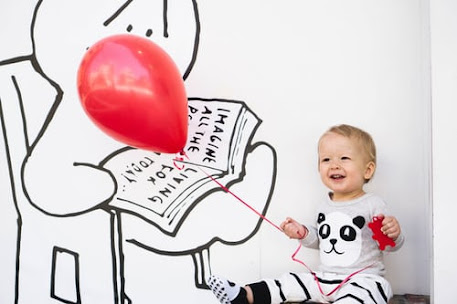How to develop a functional pencil grasp in children ?- Some smart tips
When it comes to handwriting, how a child is holding the pencil (pencil grip) plays a major role to create legible writing with ease.
Being a pediatric occupational therapist, I have come across many children who hold the pencil inappropriately, leading to difficulty in writing with ease.
There are many factors that contribute to the development of a functional or ideal pencil grip. A child needs a lot of gross motor & fine motor play activities in his early years to develop an ideal pencil grip. In this article, I will be sharing some simple activities that can be very effective in developing a child's functional grip.
How does an ideal pencil grip help a child in writing?
Holding a pencil with an ideal pencil grip allows the child to :
⏩ Move the fingers while writing(not the whole hand, the wrist or the arm),
⏩ Finish a writing or drawing task easily without getting tired.
⏩ Complete a writing or drawing task neatly.
1-) Activities with Clothespins
Clothespins are the best tools when it comes to pencil grip!
They are easily available, great for developing a three-finger grasp for pencil holding, and can be used in various ways!
Materials needed:-
▪️ Colorful clothespins
▪️ Chart paper
▪️ Thin cardboard
▪️ Colours (sketch pens /markers)
▪️ Rope
👉 Press the clip
Use clips( clothespins) to press and fix on a thin cardboard .
Then press and remove one by one.
👉Match the color
➧ To make it more fun, you can make some circles of different colours on a chart paper or thin cardboard.
Then, ask him to fix the same colour clips over the respective colour circles.
👉Clip ABCCut 26 pieces of a chart paper and write A-Z on them using sketchpens or marker.
Tie a rope at shoulder height of your kid. Ask him to find out and clip A-Z in a sequence.
👉Colour sortingUse 3–4 different colour clips.
There should be a few clips of each colour.
Ask your kid to sort out different colours and clip each one at the back of the same colour clip.
2-)Rubberband activity
This is a great activity that helps to develop pincer grasp in kids. A very simple activity to increase finger strength and can be used in many variations as well as focusing on different areas.
Can be given to toddlers. They love this activity.
👉 Put Rubberbands around a bottle
Materials needed:-
▪️ Any water bottle or tin can or anything cylindical.
▪️ Lots of colorful rubber bands
Steps:-1. Use a bottle or anything cylindrical.
2. Help your kid to pick up 1 rubber band,
pull it with his fingers and put it around a bottle...
3. Then remove them one by one.
(Make sure he uses his two fingers {Thumb & index} to pull the rubber bands while putting around the bottle and removing them. )
Or Thumb, index, and middle fingers for younger kids.
3-) Playdough activity
Using playdough has multiple benefits for kids. You can also use kneaded “atta" as a variation.
Materials needed:-
▪️ Playdough (any colours)
▪️ Any small objects (coins, beads, beans, small pegs )
▪️ If you don’t have beads/small pegs, you can use green peas/raajma beans/chickpeas also.
▪️ Pencil
👉 Find the hidden treasure
Steps:-1.Make a spherical shape playdough.
2.Insert some small beads/coins in it.
3.Ask your kid to pinch the playdough with his fingers, find the bead and name it’s colour.
It’s an excellent activity to develop your child’s finger strength and fine motor skills.
➧ If beads are not available, you can put rajma beans/chickpeas inside the playdough & ask your child to remove them one by one.
👉 Pinch the playdough with 3 fingers
Steps:-1. Knead the playdough or atta into a cylindrical shape.
2.Ask your child to use his three fingers to pinch off small pieces of playdough.
3. Then, roll them into small circles.
Keep doing till all the playdough is finished.
👉 Making different shapes/letters/numbers
Roll the playdough into small cylindrical pieces. Ask your child to make different shapes/letters/numbers with it.
Let your kid use his/her imagination and make anything out of the playdough.
It’s an excellent fine motor activity that builds their imaginative skills as well.
👉 Write on playdoughThis is a wonderful activity to help develop and strengthen three finger grasp in kids.
Steps:
1.Roll the playdough into a thick flat piece.
2. Use a pencil to make lines/write letters on it slowly.
3. Ask your kid to copy you, or hold his hands and help him to make different strokes/ write letters on playdough.
5-)Tear & Paste
This activity is enjoyed by all kids & it is very beneficial to develop pre-writing skills and ideal pencil grip. This activity helps to:
➧Strengthen small muscles of the hand
➧Enhances fine motor control
Thus, if you can practice these activities, they will help your child build a strong foundation making their writing work much easier & they will not miss out on learning opportunities due to difficulty in writing.
Try out!
Enjoy reading!
Happy parenting to all my readers.😄
About the writer :-
The writer’s name is Abhipsa Parida. She is an occupational therapist specialised in pediatrics and has been handling kids with special needs since 5 years. She is quite experienced and skillful in observation, assessment and planning intervention for kids with special needs. She uses evidence based practice and is very creative and updated in her approach while handling kids with special needs. She has her own clinic in Bhubaneswar and has handled many kids of different age groups with varying needs.
If you have any queries, you can mail them at abhipsaot21@gmail.

















Comments
Post a Comment